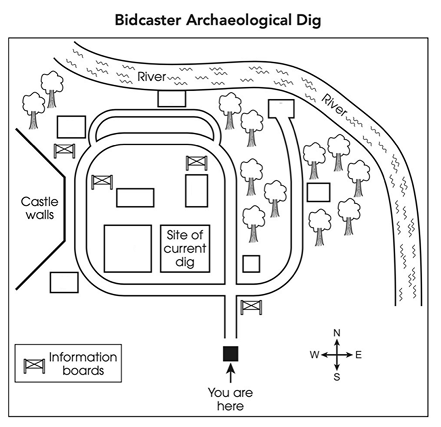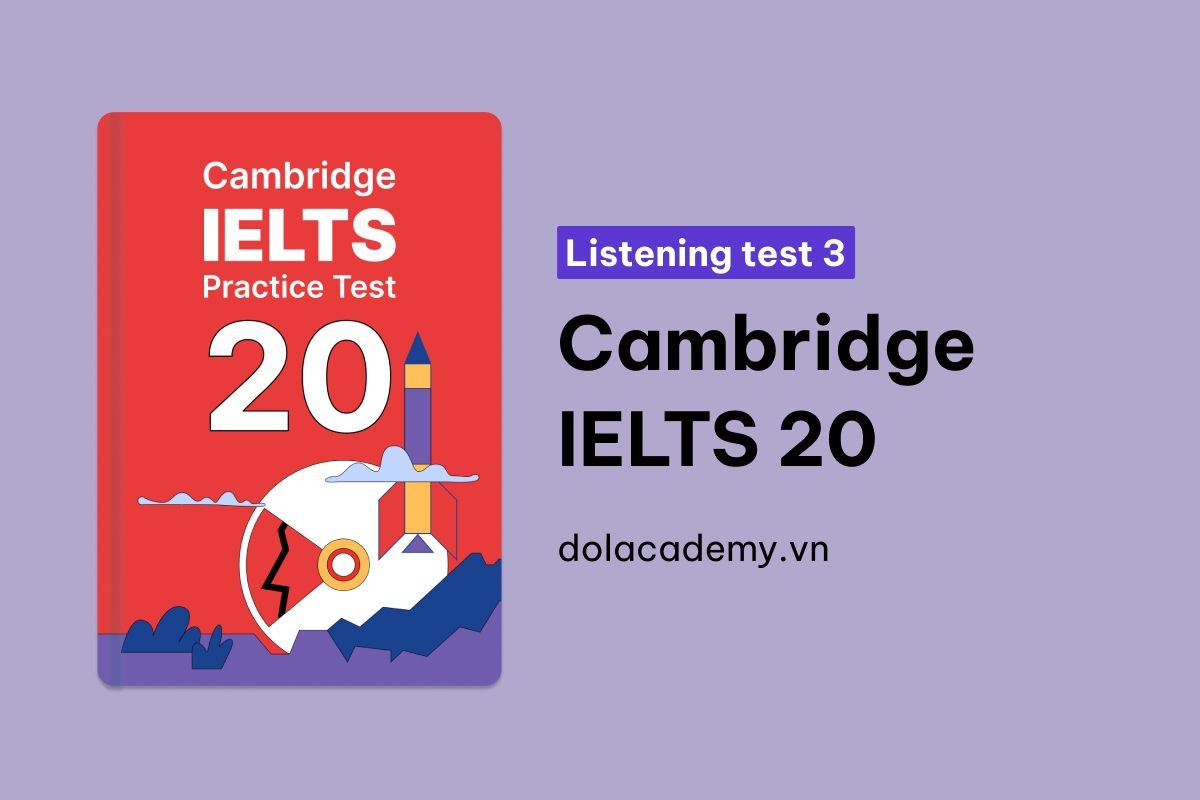Cambridge IELTS 20 - Listening Test 3 With Practice Test, Answers And Explanation
Luyện tập đề IELTS Online Test Cambridge IELTS 20 - Listening Test 3 được lấy từ cuốn sách Cambridge IELTS 20 với trải nghiệm thi IELTS trên máy và giải thích đáp án chi tiết bằng Linearthinking, kèm answer key và list từ vựng IELTS cần học trong bài đọc.
Section
👂️ Bài nghe section 1
❓ Tapescript section 1
🔥 Đáp án & giải thích section 1
Giải thích chi tiết
Hello Dolbie 🤩
Cùng chinh phục câu hỏi này nhé 😁
🎯Xác định loại từ cần điền: Chỗ trống cần điền là một con số (tổng tiền), vì nó là giới hạn trên của phạm vi giá ("Prices range from $105 to $___").
▶️ Thông tin cần nghe ở: đoạn 02:27 - 02:35 trong audio: "It says the monthly price per room starts at $105 and goes up to $239."
☺️ Cùng xem giải thích nhé: Người chủ nhà đọc thông tin từ brochure của Peak Rentals, nói rằng giá hàng tháng cho mỗi phòng bắt đầu từ $105 và "goes up to $239". Đây chính là giới hạn trên của khoảng giá.
✅ Đáp án đúng: 239
🧐 DOLBIE lưu ý: ❌ 105 => "105" là giới hạn dưới của mức giá, không phải số cần điền vào chỗ trống cuối cùng của "Prices range from $105 to $___".
Chúc Dolbie học tốt và tự tin hơn trong bài thi IELTS nha 🥳💪
Section
👂️ Bài nghe section 2

❓ Tapescript section 2
🔥 Đáp án & giải thích section 2
Giải thích chi tiết
❓Câu hỏi: Who was responsible for starting the community project? ✅ Đáp án đúng: B. a national charity ▶️ Bắt đầu nghe ở: Đoạn Hayden giới thiệu vai trò của mình và nói ai đã mời anh ấy tham gia: “I was asked to join the project by NHA, a charity …” (khoảng 01:33)
☺️ Giải thích đáp án:
Đọc câu hỏi, xác định từ khóa cần nghe: responsible for starting (= ai đứng ra khởi xướng/thiết lập dự án).
Trong audio có chi tiết quan trọng: Hayden nói anh ấy được mời tham gia bởi NHA và NHA là “a charity which sets up projects like this…” → nghĩa là tổ chức này chuyên lập ra các dự án kiểu này.
Vì vậy, đơn vị chịu trách nhiệm bắt đầu dự án là một tổ chức từ thiện cấp quốc gia → chọn B.
🧐 Lưu ý: ❌ A. the castle owners => Chỉ cho mượn cơ sở vật chất: “the owners let us use their facilities”, không phải người khởi xướng dự án. ❌ C. the local council => Hayden làm cho hội đồng (“I’m a full-time archaeologist for the town council”) nhưng dự án được NHA mời/thiết lập, nên dễ nhầm “council” là bên bắt đầu nếu nghe lướt.
Section
👂️ Bài nghe section 3
❓ Tapescript section 3
🔥 Đáp án & giải thích section 3
Giải thích chi tiết
Hello Dolbie 🤩 Cùng chinh phục câu hỏi này nhé 😁
🌱 Đọc hiểu câu hỏi: → Câu hỏi này hỏi về điều mà Finn hài lòng khi khám phá ra liên quan đến chủ đề dự án của họ. Dolbie cần nghe xem điều gì khiến Finn cảm thấy vui hoặc tích cực về việc chọn chủ đề này.
▶️ Bắt đầu nghe ở: 01:29 (Đoạn này Finn sẽ bày tỏ cảm xúc về chủ đề).
☺️ Giải thích: → Finn nói: "Even though I struggled to find many useful websites, I'm glad we picked this subject." (Mặc dù tôi đã phải vật lộn để tìm nhiều trang web hữu ích, tôi vẫn vui vì chúng ta đã chọn chủ đề này). Điều này cho thấy anh ấy hài lòng. → Sau đó, Finn giải thích lý do: "No one else on the course is doing the same as us, although it is one of the research areas of the module convener." (Không ai khác trong khóa học đang làm chủ đề giống chúng ta, mặc dù nó là một trong những lĩnh vực nghiên cứu của giảng viên module). → Maya sau đó nói: "That might actually put some people off." (Điều đó thực ra có thể khiến một số người nản lòng). Điều này xác nhận rằng việc không ai chọn chủ đề này là một điểm đặc biệt. => Vậy, Finn hài lòng vì chủ đề của họ chưa được các sinh viên khác chọn.
✅ Đáp án đúng: B
🧐 DOLBIE lưu ý:
❌ A. Was not familiar to their module leader: Finn nói "it is one of the research areas of the module convener" (nó là một trong những lĩnh vực nghiên cứu của giảng viên module), nghĩa là giảng viên rất quen thuộc với chủ đề này.
❌ C. Did not prove to be difficult to research: Finn nói rõ "I struggled to find many useful websites" (tôi đã phải vật lộn để tìm nhiều trang web hữu ích), điều này cho thấy việc nghiên cứu có khó khăn, chứ không phải không khó.
Chúc Dolbie học tốt và tự tin hơn trong bài thi IELTS nha 🥳💪
Section
👂️ Bài nghe section 4
Definition
Designing products that can be accessed by a diverse range of people without the need for any
31..Not the same as universal design: that is design for everyone, including catering for people with
32.problems.
Examples of inclusive design
33.which are adjustable, avoiding back or neck problems.
34.in public toilets which are easier to use.
To assist the elderly:
Designers avoid using
35.in interfaces.People can make commands using a mouse, keyboard or their
36..
Impact of non-inclusive designs
Access
Loss of independence for disabled people.
Safety
Seatbelts are especially problematic for
37.women.PPE jackets are often unsuitable because of the size of women's
38..PPE for female
39.officers dealing with emergencies is the worst.
Comfort in the workplace
The
40.in offices is often too low for women.
❓ Tapescript section 4
🔥 Đáp án & giải thích section 4
Giải thích chi tiết
Hello Dolbie 🤩
Cùng chinh phục câu hỏi này nhé 😁
🎯Xác định loại từ cần điền: Chỗ trống cần điền là một danh từ, vì nó đứng sau "any" và là thứ mà thiết kế bao trùm không cần đến.
▶️ Thông tin cần nghe ở: đoạn 01:28 - 01:41 trong audio: "It means making sure products are accessible so that as many different types of people as possible can use them without any type of adaptation having to be made to the original design."
☺️ Cùng xem giải thích nhé: Người nói định nghĩa thiết kế bao trùm là đảm bảo sản phẩm có thể được sử dụng bởi nhiều người mà "without any type of adaptation having to be made" ("mà không cần phải thực hiện bất kỳ sự điều chỉnh nào").
→ Từ "adaptation" (sự điều chỉnh/thích nghi) khớp với chỗ trống, vì nó là điều không cần thiết khi thiết kế bao trùm.
✅ Đáp án đúng: adaptation
🧐 DOLBIE lưu ý:
❌ design
=> "Design" là khái niệm chung về việc thiết kế sản phẩm. Câu hỏi đang hỏi về thứ mà người dùng không cần đến để sử dụng sản phẩm một khi sản phẩm đã được thiết kế một cách bao trùm
=> "Adaptation" (sự điều chỉnh/thích nghi) mới là từ phù hợp, vì sản phẩm đã được thiết kế sẵn để mọi người dùng được mà không cần thay đổi gì thêm.
Chúc Dolbie học tốt và tự tin hơn trong bài thi IELTS nha 🥳💪


